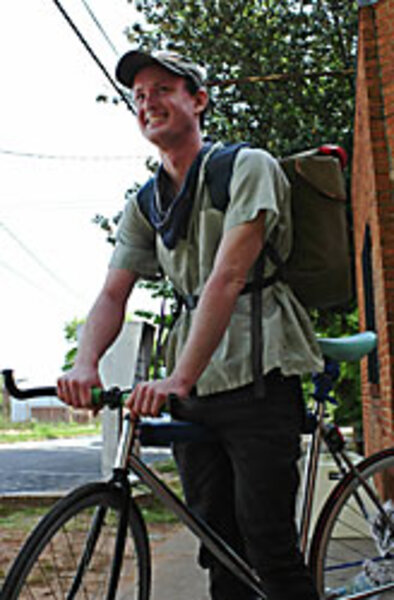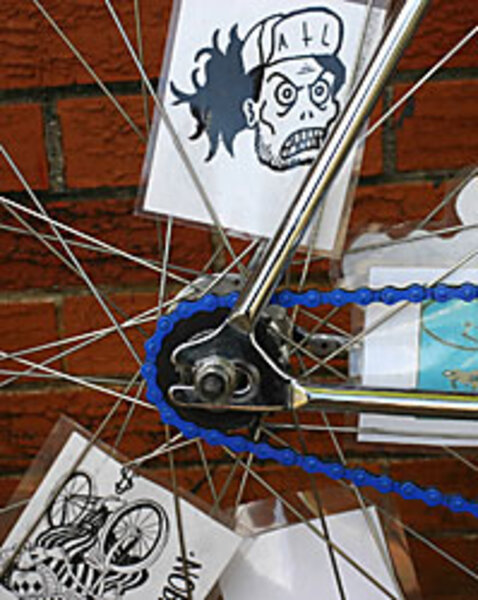Back-to-basics biking movement takes hold in cities
| Atlanta
John "2Tone" Woodroof rides his bike the way an intrepid sea captain rides a storm: always moving, eyes peeled to the horizon. Zipping around Atlanta's mean streets, Mr. Woodroof is the epitome of two-wheeled bravura.
He and his comrades match a punk rock aesthetic with a bike courier twist: Their essential fashion statement being scuffed Vans sneakers and leg-hugging jeans, a practical chain-avoiding attire that gives them the profile of asphalt-sailing buccaneers.
But the most impressive piece of Woodroof's outfit is his bicycle: A stripped-down race bike with no brakes and a single-speed, fixed-gear rear hub that, in effect, turns man into a cog of the machine. This is biking at its most primal – no stopping, no coasting with the pedals stationary, no helmets. It's a ride built on adrenaline and danger, like walking across a lava flow in flip flops.
"All you need is air in the tires and a chain that works," says Woodroof, who co-owns No Brakes, one of the only bike shops devoted solely to so-called "fixie" bikes in the Southeast. "It's about simplicity."
In some of the toughest traffic in the country – New York, Atlanta, Chicago, Los Angeles – recreational bikers are stripping down their Schwinns and Cannondales and going back to the original setup that can be seen in pictures from the first Tour de France. Put another way, they're riding bikes torn from the velodrome and plunked down in the urban jungle. The fixed-gear movement is, in fact, influenced by track racing, especially a Japanese version called "keirin."
It is also rooted in a rebellion against the overaccessorized culture of spandex and 21-speed bikes of normal cycling. Its popularity can be seen in the number of clubs springing up, new shops catering to riders, and manufacturers starting to build bikes long thought to be an anachronism.
Yet, as with any edgy movement, a backlash is brewing. Some motorists question the sanity – and legality – of no-brake biking, while even a few professional riders, though impressed with the devotees' courage, worry about their astuteness. "These guys are adrenaline junkies," notes Atlanta track racer Leigh Foti. "They're going out there with no brakes!"
Zane Freebairn of Salt Lake City has become a fixie fanatic. He's given up his car. All he does now is ride his one-speed bike. "It's the most basic form of cycling you can ever do," he says. "You can wear your tennis shoes and your walking clothes. There's one gear, no brakes, no cables, not many moving parts, and nothing to break." He says the movement has gotten "huge" in Salt Lake City in just the past year.
Fixie riders are often sly and clubby, the very definition of cliquish. Most are young to middle-age white men. Many are as leery of authority as the punk rock tunes they pump through their iPods.
"It's been referred to as an old boys' club, primarily by women," says Jay Townley, a bike industry analyst in Lyndon Station, Wis.
The movement is being driven by growing numbers of young people who are moving into downtown areas and searching for outlets for adventure. In the no-brake bikes, they find it. Enthusiasts wear bumps and bruises like badges of honor, and organized events often feature awards for "best crash."
They may also be changing the politics of biking. On the one hand, fixie riders bring an energy and excitement to mainstream biking that could help open up roadways to more than just Saabs and SUVs. "What I love about fixed gears is the culture – it has brought so much pride to bicycling," says Sue Knaup, the executive director of One Street, a bicycle advocacy group in Prescott, Ariz. The movement "embodies the quintessential goal of bicycle advocacy: to create streets where the most vulnerable users can flow out into them and not be run down."
Chicago recently took steps to bolster the rights of cyclists – a move not spawned by no-brake enthusiasts, but one they'll benefit from. The city is increasing fines for motorists who cut off bikers. It's a sign Chicago is attempting to become "more like a European city, where the law protects the more vulnerable users, whether they're fixie riders or farmers on tractors," says Randy Neufeld of the Chicagoland Bicycle Federation, an advocacy group.
Yet critics, some of them bikers, believe fixie riders could turn public goodwill into animosity. More than cruisers or mountain bikers, fixie riders tend to challenge motorists on the roads.
Nor do they engender much sympathy for riding around with no brakes. Their public image wasn't helped when a rider in Chicago was killed in February during an unsanctioned race called an "alley cat." The rider's bike had brakes, but the race included many fixed-gear bikers. Riders canceled an alley cat race scheduled for New York the following month.
As the movement grows, manufacturers are looking for ways to put more fixed-gear bikes on the road. Giant, a major bike supplier in Newbury Park, Calif., recently began offering street-ready models. Another manufacturer, Specialized, is developing bikes for release later this year with designs targeted at specific cities.
The New York version will be painted taxi-cab yellow and have short handlebars to squeeze through Fifth Avenue traffic. The Seattle one will have mudguards and a coffee-cup holder. The London bike will feature a Tube motif that echoes the subway system. The Langster Chicago model is already being called the "gangster."
Fixie bikes will likely never constitute a mass market. For one thing, they're difficult to ride. For another, many are illegal. US import law and many municipal codes require mechanical braking devices on bikes. While manufacturers' models have them, riders usually take the mechanisms off. So far, authorities have rarely enforced such codes. But more mishaps could bring a crackdown.
Riders, for their part, argue that their legs are the brakes and that maneuvers such as hop stops, fish tails, and slides enable them to ride safely. A full emergency stop is executed by the rider leaning forward and pushing back on the pedal. "But you can't stop instantly," admits Woodroof.
Sergio Brands, an Atlanta waiter, quickly discovered the perils of the new sport. He stopped by No Brakes to pick up a $950 red-and-black bike with saucer-thin tires that he'd been scouting for some time. But his foot got caught in the toe-clip and he fell on his first test ride. He paused to rethink the purchase.
Stewart Harding, a pizzamaker and part-time bike mechanic, knows fixie riding isn't for the faint of foot. "I don't think we're the smartest group of bikers out there necessarily," admits Mr. Harding, who recently removed the brakes from his two-wheeler. "If you don't know what you're doing, this is a million times more dangerous than a regular bike."
Still, Atlanta resident Chris Sturdivant, echoing past debates over motorcycle helmets and other safety devices, believes riders themselves should decide what accessories bikes have. And he is aware of the dangers. An airport van recently swerved into his bike on a downtown street. He sued the company, and a judge ordered the firm to pay for the damage – a new tire. "This is the best way to get around," says Mr. Sturdivant, undeterred by his mishap. "You have an unbelievable amount of power on these bikes. You just push down on the pedal and you're gone."







